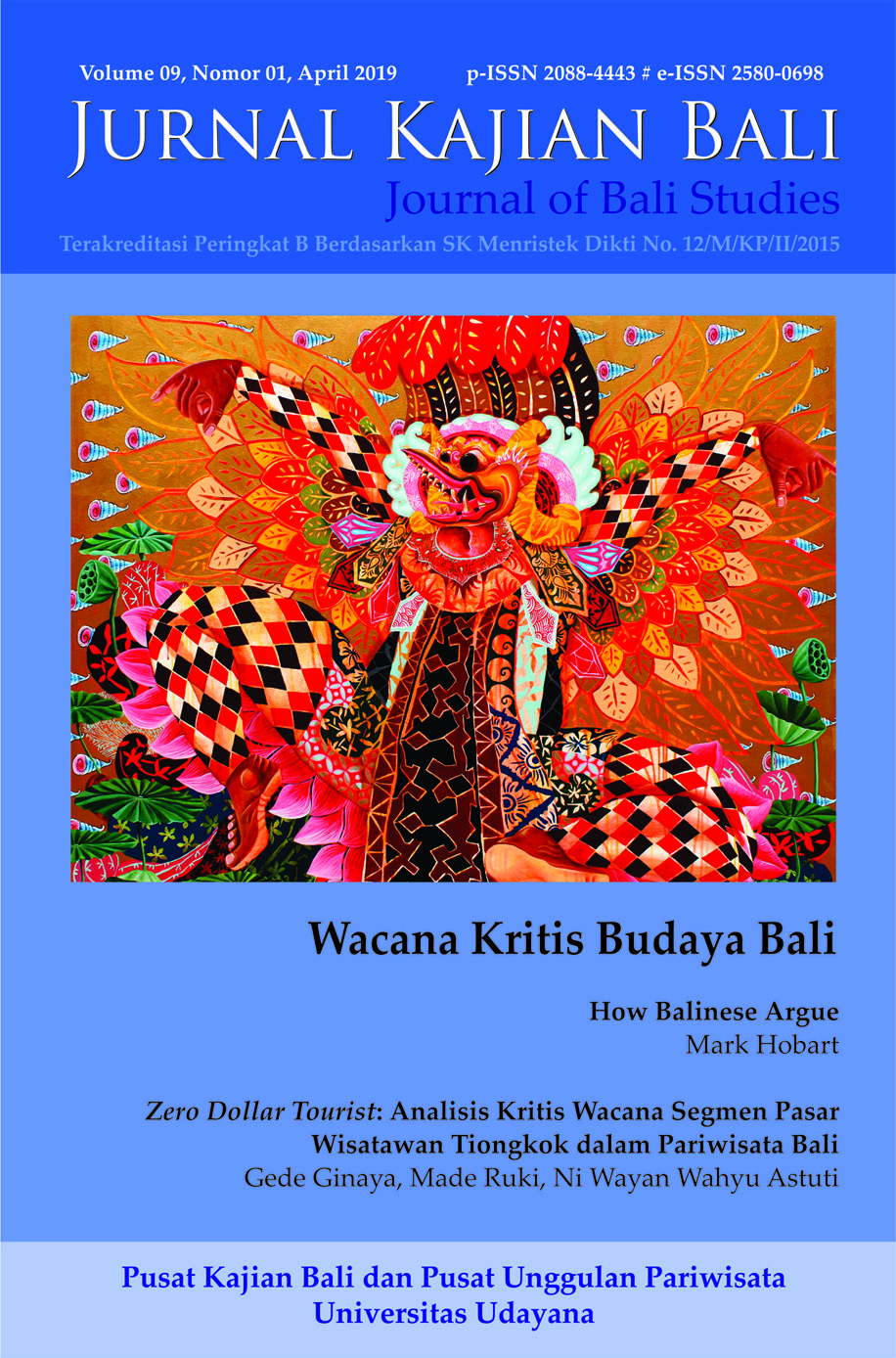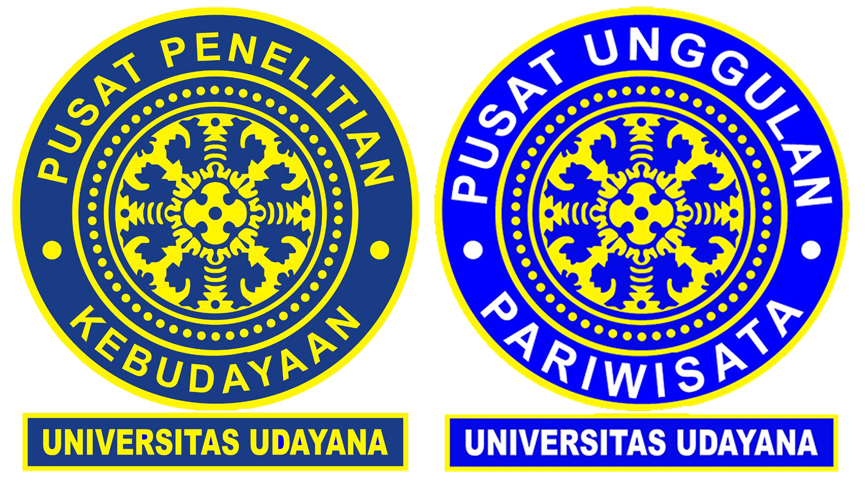The Rhetoric of Paintings: Towards a History of Balinese Ideas, Imaginings and Emotions in the Late Nineteenth and Early Twentieth Centuries
Abstract
Western historical scholarship has taught us much about Southeast Asia in the period between 1800 and 1940. This was a time when the insistent, intensifying and transforming influence of Dutch colonial society and its culture became widespread in Bali and more broadly in the archipelago. Much too has been written about the analytical framework of European histories of these times. In this essay I discuss Balinese paintings from this same period which shed light on how painters and their works spoke to their viewers both about how the Balinese knew, imagined, thought and felt about the world in which they lived and about the visual representation and communication of these ideas, imaginings and feelings through the medium of narrative paintings. In this paper I hope to draw attention to a number of historiographical issues concerning the reception of the ideas, imaginings and feelings conveyed in paintings. In particular I shall have some remarks to make about the role of philology in this regard.
Downloads
References
Behrend, T. E., 1987, ‘The Serat Jatiswara: Structure and change in a Javanese poem. PhD Thesis, Australian National University, Canberra.
Acri, Andrea, 2011, ‘A new perspective for “Balinese Hinduism” in the light of pre-modern religious discourse’. A Textual approach’ in Michel Picard and Remy Madinier (eds.), The Politics of Religion in Indonesia: syncretism, orthodoxy, and religious contention in Java and Bali. London and New York:Routledge, Taylor & Francis Group.
Acri, Andrea , 2013, ‘Modern Hindu Intellectuals and Ancient Texts: Reforming Śaiva Yoga in Bali’. Bijdragen tot de Taal-, Land- en Volkenkunde 169:1–36.
Acri, Andrea, 2017, Dharma Pātañjala: A Śaiva Scripture from Ancient Java in the Light of Related Old Javanese and Sanskrit texts. 2nd Edition. New Delhi: Aditya Prakashan [Groningen:Egbert Forsten/Brill, 2011]
Arps, Bernard, 2016, Tall Tree, Nest of Wind. The Javanese Shadow-play Dewa Ruci Performed by Ki Anom Soeroto. A Study in Performance Philology. NUS Press, Singapore.
Arwati, Ni Made Sri, 1992, Hari Raya Galungan, Denpasar: Upada Sastra.
Becker, Alton (ed.), 1989, Writing on the Tongue. Michigan Papers on South and Southeast Asia 33, Centre for South and Southeast Asian Studies, The University of Michigan.
Behrend, Y. E., 1987, The Serat Jatiswara; Structure and Change in a Javanese poem. [PhD thesis, Australian National University, Canberra.]
Belo, Jane, 1966, Bali: Temple Festival, Seattle and London:University of Washington Press. [Monograph of the American Ethnological Society 22]
Bloemen Waanders, P. L., 1859, ‘Aanteekeningen omtrent zeden en gebruiken der Balinezen inzonderheid van Boeleleng’, Tijdschrift voor Indische Taal-, Land-, en Volkenkunde 8 (3e serie part 2):105–279.
Brinkgreven, Francine, 2005–2006, ‘Balinese chiefs and colonial rule: the creation of collections, and politics’, in Endang Sri Hardiati and Pieter ter Keurs (eds.), Indonesia: the discovery of the past, Amsterdam: KIT Publishers:122–145.
Brinkgreven, Francine, Hout, Itie van, 2005–2006, Java: Gifts, scholarship and colonial rule’, in Pieter ter Keurs (ed), Colonial collections revisited, Leiden: CNWS Publications:100–121.
Brinkgreven, Francine, Stuart-Fox, David, 2007, ‘Collections after Colonial Conflict; Badung and Tabanan 1906–2006’, in Pieter ter Keurs (ed), Colonial collections revisited, Leiden: CNWS Publications:145–185.
Brinkgreve, Francine and Rapti Miedema, 2008, ‘Doeken voor een dode vorst’, Aziatische Kunst 38:8–22.
Broek, van den, H. A., 1834, ‘Verslag nopens het eiland Bali; de vorsten, hunne geaardheid en betrekkingen, den handel, de cultuur, de bevolking, hare zeden en gewoonten, godsdienst en andere bijzonderheden’, De Oosterlingen 1:158–236.
Campbell, S., 2013, ‘Collecting Balinese Art: The Forge Collection of Balinese Paintings at the Australian Museum in Sydney’, PhD Thesis University of Sydney.
Covarrubias, M., 1937, Island of Bali. London, Toronto, Melbourne & Sydney: Cassell.
Creese, Helen, 1998, Pārthayāna: The journeying of Pārtha; An eighteenth century Balinese kakawin. Leiden: KITLV Press. [Bibliotheca Indonesica 27.]1
Creese, Helen, 2001, ‘Old Javanese studies’: A review of the field’, Bijdragen tot de Taal-, Land- en Volkenkunde 157-1:3–33.
Creese, Helen, 2016, Bali in the early nineteenth century: The ethnographic accounts of Pierre Dubois, Leiden and London: Brill, [KITLV Verhandelingen 305].
Eck R. van, 1878–1880, ‘Schetsen van het eiland Bali’, Tijdschrift voor Nederlandsch-Indië, Nieuwe Serie 7–9.
Forge, A., 1977, ‘Schematisation and meaning’, in Peter J. Ucko (ed.), Form in Indigenous and Schematisation in the Art of Aboriginal Australia and Prehistoric Europe. Canberra: Australian Institute of Aboriginal Studies [Prehistory and material
culture Series 13.]
Forge, A., 1978, Balinese Traditional Paintings. A selection from the Forge Collection of the Australian Museum, Sydney. Sydney: The Australian Museum.
Forge, A., 1980, ‘Tooth and Fang’, Canberra Anthropology 3:1–16.
Fox, Richard, 2003, ‘Substantial transmissions; A presuppositional analysis of the old Javanese text as an object of knowledge, and its implications for the study of religion in Bali’, Bijdragen tot de Taal-, Land- en Volkenkunde 159:65–107.
Fox, Richard, 2005, ‘Plus ça change...Recent developments in Old Javanese studies and their implications for the study of religion in contemporary Bali’, Bijdragen tot de Taal-, Land- en Volkenkunde 161:63–97.
Goris, R., 1960, ‘Holidays and Holy Days’, in Swellengrebel, J. L. (ed.), Bali: Studies in Life, Thought, and Ritual, The Hague and Bandung:113–129. [Originally published in Goris, R.,1933 as ‘Bali’s hoogtijden’, Tijdschrift voor Indische Taal-, Land-, en Volkenkunde 73:436–452]
Grader, C. J., 1939, ‘Brayoet: de geschiedenis van een Balisch gezin’, Djawa 19:260–275.
Gunarsa, Nyoman et al,. 2006, Classical Balinese Painting Nyokan Gunarsa Museum, Nyoman Gunarsa Museum of Classical Balinese Painting and Gateway Books International.
Hardiati, Endang Sri and Pieter ter Keurs, 2005–2007, Indonesia: the discovery of the past, Amsterdam: KIT Publishers.
Hinzler, H. I. R., 1986, ‘The Usana Bali as a source of history’, in Taufik Abdullah (ed.) Literature and History, Volume Two, Papers of the Fourth Indonesian-Dutch History Conference, Yogyakarta, 24–29 July 1983. Gadjah Mada University Press:124–162.
Hobart Mark, 2017, ‘Murder is fine but argument is anathema’, Conference Version, How Indonesians Argue, EuroSEAS Conference, University of Oxford, 16–18th August 2017. http://www.criticalia.org/symposia--panels/its-fine-to-pull-his-head.pdf
Hooykaas, C., 1977, A Balinese temple festival, The Hague: Nijhoff [KITLV Bibliotheca Indonesica 15].
Inden, Ronald, Jonbathon Walters and Daud Ali, 2000, Querying the Medieval. Texts and the history of practices in South Asia, Oxford: Oxford University Press.
Kanta, I Made, 1977–1978, Proses melukis tradisionil wayang Kamasan. Den Pasar: Proyek Sasana Budaya Bali.
Kat Angelino, P. de, 1921–1922, ‘Over smeden en eenige andere ambactslieden op Bali’, Tijdschrift voor Indische Taal-, Land- en Volkenkunde 60:207–265, 61:370–424.
Kemp, P. H. van, 1899, ‘Het verblijf van Commissaris van den Broek op Bali van 18 December 1817 tot 24 Juni 1818’, Bijdragen tot de Taal-, Land- en Volkenkunde 50:331–390.
Keurs, Pieter ter, 2007, Colonial collections revisited, Leiden: CNWS Publications.
Lunsingh Scheurleer, Pauline, 2007, ‘Collecting Javanese Antiquities’, in Pieter ter Keurs (ed), Colonial collections revisited, Leiden: CNWS Publications:71–114.
Lunsingh Scheurleer, Pauline, 2011, ‘The Berlin Hermit and its Lost Provenance’, Indo-Asiatische Zeitschrift 15:10–30.
Meij, Dick van der, 2016, Indonesian Manuscripts from the islands of Java, Madura, Bali and Lombok. Handbook of Oriental Studies/ Handbuch der Orietnalistik, Southeast Asia 24, Brill: Leiden Boston.
Molen, W. van der, 1983, Javaanse tekskritiek; Een overzicht en een nieuwe benadering geillustreed aan de Kuñjarakarṇa. Dordrecht, Floris [KITLV, Verhandelingen 102.]
Molen, W. van der, 2011, Kritik Teks Jawa; Sebuah pemandangan umum dan pendekatan baru yang diterapkan kepada Kunjarakarna. Yayasan Pustaka Obor Indonesia, Jakarta.
Pollock, Sheldon, 2014, ‘Philology in three dimensions’, postmedieval: a journal of medieval cultural studies 5:398–413.
Pollock, Sheldon, 2015, ‘Liberating Philology’, Verge: Studies in Global Asias:16–21.
Proudfoot, I., 1984, ‘Variation in a Malay folk-tale tradition’, Review of Indonesian and Malaysian Affairs 18:87–98.
Robson, S. O.,1972, Wangbang Wideya: a Javanese Pañji romance. The Hague: Nijhoff. [KITLV, Bibliotheca Indonesica 6.]
Robson, S. O., 1988, Principles of Indonesian Philology, Koninklijk Instituut voor Taal-, Land-, en Volkenkunde, Working Papers 1.
Rubinstein, R., 2000, Beyond the realm of the senses; The Balinese ritual of kekawin composition. Leiden: KITLV Press. [KITLV, Verhandelingen 181]
Sirikanden, 1982, Galungan, Denpasar: Penerbit & Toko Buku Ria.
Sugriwa, I Gusti Bagus, 1957, Hari Raya Bali Hindu. Den Pasar: Pustaka Balimas.
Surpha, I Wayan, 1972, Menjongsong Hari-hari raja “Galungan”. Badung: Parisada Hindu Dharma.
Smith, Valerie J., 2007, ‘Aristotle’s Classical enthymeme and visual argumentation of the twenty-first century’, Argumentation and Advocacy 43:114–123.
Terwen-de Loos, J., 1967, ‘Brajoet of het nieuwe leven’, Verre Naasten Naderbij, 1e Jaargang no. 3:9–21.
Terwen-de Loos, J., 1969 ‘Een oude Brajoet herontdekt’, Verre Naasten Naderbij, 3de Jaargang, no. 2:48-51.
Tuuk, H. N. van der, 1897–1912, Kawi-Balineesch-Nederlandsch Woordenboek. Batavia: Landsdrukkerij. 4 vols.
Vickers, A., 1979, ‘Kerta Ghosa: The Ordered Realm’, BA (Hons) thesis, Department of Indonesian and Malayan Studies, University of Sydney.
Vickers, A., 1982, ‘A Balinese illustrated manuscript of the Siwaratrikalpa’, Bijdragen tot de Taal-, Land-, en Volkenkunde 138:443–469.
Vickers, A., 1984, ‘When is a text not a text? The Malat and Philology’, Review of Indonesian and Malayan Affairs 18:73¬–86.
Vickers, A., 1985, ‘Commoner temple, commoner painters: the village temple and traditional Balinese painting’, in Masselos J. (ed.), Popular Art in Asia: the people as patrons. Sydney: Centre for Asian Studies: 1–21
Vickers, A., 2005, Journeys of desire; A Study of the Balinese Text Malat. [KITLV, Verhandeling 217].
Vickers, A., 2012, Balinese Art: Paintings and Drawings of Bali 1800–2010. Singapore: Tuttle Publishing.
Wiratmadja, Gusti Ketut Adia, 1969, Hari Raya : Galungan. Hari Raya: Kuningan, Magelang.
Worsley, P. J., 1970, "A Missing Piece of a Balinese Painting of the Siwaratrikalpa", Bijdragen tot de Taal-, Land-, en Volkenkunde, 126.
Worsley, P. J., 1972, Babad Buleleng:A Balinese dynastic genealogy. The Hague: Nijhoff. [KITLV, Biblitheca Indonesica 8.]
Worsley, P. J., 1984, ‘An Old Javanese poem; Methodological problems of textual analysis’, Asian Studies Association of Australia Review 8-1:104–108.
Worsley, P. J., 2011, ‘A new date of a painting of the Siwaratrikalpa’, ManjuShree (ed.): From beyond the eastern horizon; Essays in honour of Professor Lokesh Chandra. New Delhi: Aditya Prakashan., pp. 205–214.
Worsley, P. J., 2014, ‘The History of a narrative. The Story of Prince Aja and Princess Indumatī in Nineteenth and Early Twentieth Century Bali’, Journal of Hindu Studies:1–26.
Worsley, P. J., 2016a, ‘Kisah Brayut dalam Lukisan Kamasan dari Abad ke-19 dan ke-20’. Jurnal Kajian Bali 6 (2).
Worsley, P. J., 2016b, ‘The Games painters play: visual design in Balinese paintings from Kamasan’, Second International Symposium on How Indonesians Argue, Oxon. Online at: http://www.criticalia.org/symposia--panels/how-indonesians-argue-2.html.
Worsley, P. J., 2017, ‘Ritual in Balinese Paintings: a Balinese Brayut Painting from the Nyoman Gunarsa Museum Bali’, TAASA Review 3.
Zurbuchen, Mary Sabina, 1987, The language of Balinese Shadow Theatre. Princeton: Princeton University Press.

This work is licensed under a Creative Commons Attribution 4.0 International License.



















